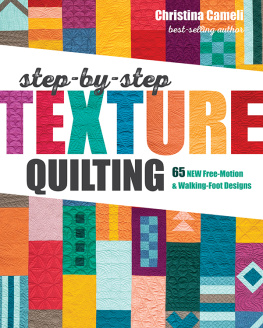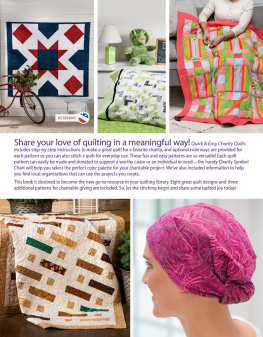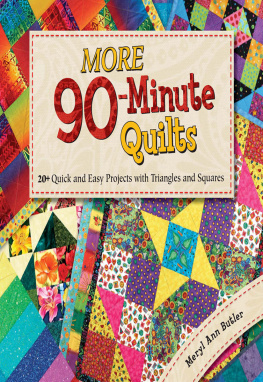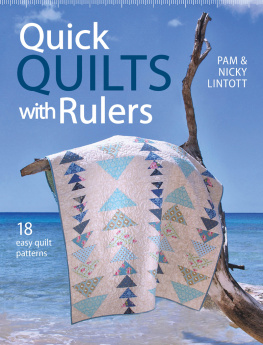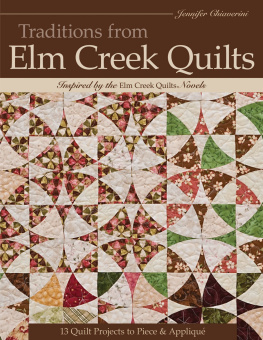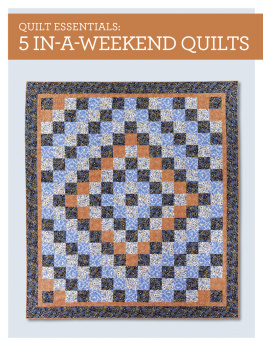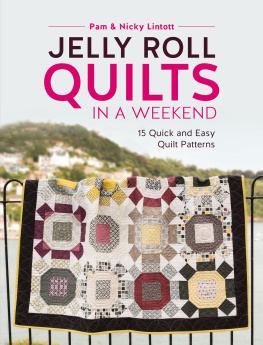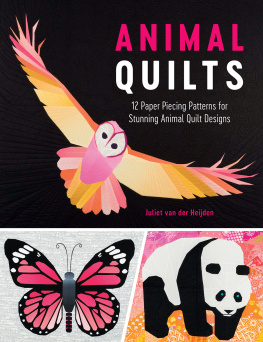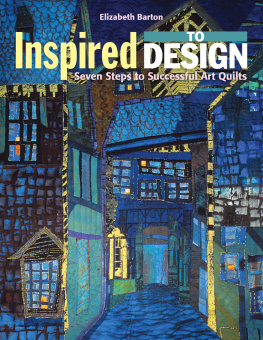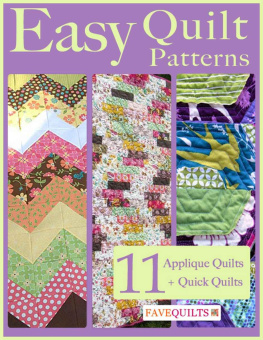PUBLISHER: Amy Marson
CREATIVE DIRECTOR: Gailen Runge
EDITORS: Karla Menaugh and Liz Aneloski
TECHNICAL EDITOR: Debbie Rodgers
COVER/BOOK DESIGNER: April Mostek
PRODUCTION COORDINATOR: Tim Manibusan
PRODUCTION EDITOR: Jennifer Warren
ILLUSTRATOR: Kirstie L. Pettersen
PHOTO ASSISTANT: Mai Yong Vang
HAND MODEL: Kristi Visser
STYLE PHOTOGRAPHY by Lucy Glover and INSTRUCTIONAL PHOTOGRAPHY by Diane Pedersen of C&T Publishing, Inc., unless otherwise noted
Published by Stash Books, an imprint of C&T Publishing, Inc., P.O. Box 1456, Lafayette, CA 94549
Dedication
To my father, Michael Camelia role model of strength, patience, kindness, and love
Acknowledgments
Wedge Quilt Workshop exists because of the incredible support I received during its creation. This book was a bigger project than Id done before, and the writing of it coincided with the process of my divorce. I found myself needing help in a way I never had, and I was humbled by the immense care and willing assistance that flowed from my community in response.
To C&T Publishing, thank you for graciously adapting the book schedule to my challenges and delays. And to my editor, Karla Menaugh, thank you for handling more anxiety and tearful conversations than any book editor should have to, for guiding me when I needed direction, and for resolving every concern I unearthed.
To Michael Miller Fabrics, thank you for the quick and bountiful supply of Cotton Couture that makes up all the solids for the quilts in this book. Thank you again and again for your help when it was most needed.
To Zihna Weiss, thank you for your joyful presence with my children as I worked, and for your continuous bright spirit and invaluable flexibility.
To my sister, Kaila Cameli, thank you for the afternoons, the evenings, the weekends, the movies, the sushi, the encouragement, and the playful generosity you bring to our home.
To my friend Shannon McNair, thank you for the heaps of encouragement and for believing this work has worth that is measured in something other than dollars.
To my most generous friends and colleagues, thank you for taking my work into your lap and finishing the binding: Juline Bajada, Michelle Freedman, Laura Gurley, Elsa Hart, Sam Hunter, Anna Long, and Elise Makler. You truly saved the day.
To Nancy Stovall, thank you for taking on an especially big project with an absurdly tight deadline. There is no way the book could have been completed without your quilting, or for that matter, without your laughter and hugs at every drop-off and pickup. I am indebted to you for the great gifts of your artistic vision and brilliant spirit.
To Bill Volckening, thank you for the generous use of quilts from the Volckening Collection. I am so grateful for the work you do, not only as your friend and colleague but also as a human and quilter at large.
And to all my readers, students, and online connectionsknow that every kind word, every enthusiastic comment, and every just checking in email kept me going and believing that this work was worth it. You kept me believing that I am a part of something special that is so much bigger than any of us individually.
You are all in this book. May you delight in it as cocreators. Without you, there would be only a dream unfinished; with you, magic appeared.
WHY WEDGES?
A few years ago, I made an impulse purchase of a wedge ruler at my local quilt shop. I was drawn in by the idea of making a large one-patch circle without needing to draft my own pattern piece. I played around with different designs and slowly fell more and more in love with this wonderful shape.
And Im not alone! Quilters have been playing with wedges for a long time, as these quilts from the Volckening Collection show.

Images courtesy of the Volckening Collection

Images courtesy of the Volckening Collection
A beloved quilt made by my great-grandmother features a Dresden Plate design. Some of the wedges have worn away, but the fabric beneath still holds. I keep this quilt on my bed. It is my connection to a woman I never meta woman whose life in some ways shaped mine. Whenever I sew my wedge creations to their backgrounds or finish their centers, I smile, realizing that generations before she had done the very same.

A Dresden Plate quilt by Beatrice Dority
I went down a few dead ends with my impulse purchase. But through optimism, experimentation, and error, I refined an approach to making rounds that came together reliably. I found that I loved working with wedges because it was a quick path to a bold quilt design. By cutting a group of basic wedges and putting them together, I was able to create a stunning product without much technical skill. That is attractive to me as a quilter because I tend to value design and impact more than technical proficiency.
You can imagine my delight, then, when I discovered wide vistas of design potential as I started doing more than making simple rounds. I was thrilled to find that when I cut up my wedge creations and sewed them together, my points matched up. If even I could get good results with wedges, other quilters needed to know about it!
So here I am, telling you there is a world of fun to be had with these shapes. Wedges are versatile and captivating. They make dynamic, graphic designs possible without complicated math or drafting. They make precision attainable without foundation paper piecing. Above all, wedges make it simple to jump in to a whole new type of quilt that, to my eyes, has limitless potential for the modern quilter.
If you like new challenges and discoveries, I imagine that this versatile approach to patchwork will delight you as it did me. Take some time to read my tips for making your wedge journey a success, and then see where it takes you!

Sacred Heart, 57 59, by Christina Cameli and Mary Ann Cameli, quilted by Christina Cameli
See the afterword to see how this quilt was made.
WEDGE BASICS
A wedge is a portion of a circle. Put the right number of wedges together, and youll have a complete circle. Wedges come in many sizes, though Ive limited the ones in this book to just a couple. What all wedges have in common is that they have a wide end and a narrow end.
A wedge is measured by the angle formed where the two slanted sides meet. This angle is measured by degrees. If youre working with a template or a wedge ruler, you dont have to worry about the angle at allthe ruler or template designer has already done the work for you. You just need to know how many wedges you need to make a complete 360 circle.


To make a whole round, use 40 of the 9 wedges.

Next page

